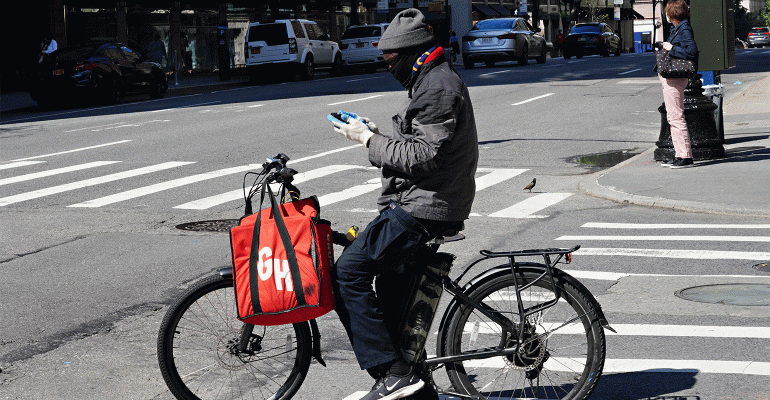Grubhub said mandated fee caps in San Francisco are hurting independent restaurant companies, which are seeing 10% fewer delivery orders since the city implemented a temporary commission cap in mid-April.
Preliminary data also shows that those orders are shifting to quick-service companies, company CEO Matt Maloney told investors during the company’s first quarter earnings call.
“That is not good for small businesses and even worse, these lost orders also result in lost wages and tips for our delivery drivers,” Maloney said.
The caps, introduced in San Francisco, Seattle and Washington D.C., come as the company is experiecing a surge in new restaurant partners, including independent restaurants.
The company said it had more restaurants go live as partners in March and April than it did in the last six months of 2019.
Controversy heating up over fees
The COVID-19 pandemic has put delivery commission fees in the spotlight with restaurant advocacy groups and city leaders advocating lower fees to give restaurants a fighting chance to survive amid mandates that allow venues to only serve customers through off-premise channels, which includes delivery.
Grubhub, in particular, has come under fire for its fee model. Last week, the company was criticized for taking advantage of restaurants during the pandemic after a small business posted its delivery invoice. It showed a pizza business selling $1,000 worth of food on the Grubhub platform, but the restaurant’s take-home after various fees was less than $400.
During the call, Maloney defended its rate structure, which he said is tailored to the needs of each restaurant client. When fees are capped, like in Seattle and San Francisco, Grubhub has to raise other fees to pay for its fixed costs such as paying delivery drivers.
That means “increasing consumer fees and spending less on marketing to diners,” Maloney said.
That results in fewer orders for lesser known restaurants because money is not being spent to raise their profile on the delivery company’s marketeplace.
“I think the one-size-fits-all model will not work and you are seeing a huge amount of frustration and anxiety around that currently when my industry is the only ability for restaurants to make money during this crisis,” Maloney said.
Maloney said Grubhub will be focusing future efforts on educating people on “the valuable role we play in the ecosystem.”
“If it wasn't Grub, the restaurants would still have to pay real costs in order to deliver,” he added.
Further, the company said it is reinvesting profits to help boost order volumes to restaurants including pumping “tens of millions of dollars” directly into promotional programs. The company said its strategy is to "frontload" certain delivery deals or bundled promotions to drive initial sales to restaurants.
Maloney said the company then asks restaurants if they want to continue campaigns “on their own dime.”
Grubhub estimates these investments will “stimulate over $150 million for food sales for our partner restaurants this quarter.”
“It’s about supporting the ecosystem at this point as opposed to taking advantage of the pandemic,” Adam DeWitt, chief financial officer, said.
New York City harming overall order growth
New York City, which is Grubhub’s largest consumer market, is dragging down overall order growth which increased 20% in April after experiencing steep declines in March during the beginning of the COVID-19 pandemic.
Maloney and DeWitt in a letter to shareholders said diners, especially those fleeing New York City, took a “a momentary step back in activity and retrenched as the gravity and uncertainty of the crisis really sunk in” in March.
“New York was certainly hit more than any other market in the U.S.,” Maloney told investors in a Thursday morning conference call.
That led to a double digit decline in year-over-year orders in March. But April, as noted by many publicly-traded companies during earnings season, is rebounding.
In April, Grubhub said its non-New York markets are experiencing a “growth surge,” with many experiencing order increases of more than 100% year-over-year.
Initially, Maloney said the company was “very afraid” that the pandemic “would decimate” neighborhood restaurants in New York City, the epicenter of the pandemic. But New York City consumer volumes are improving as more restaurants reopen for delivery and takeout.
“We're not out of the woods yet, but we're on the right track,” Maloney said.
Consumer trends: large group orders, less promiscuous
The company said orders are growing in recent weeks because of “an influx of new diners and restaurants” to the company’s platform.
New diners are coming back more frequently, and are not as promiscuous as they have been prior to the COVID-19 crisis when they shifted from platform to platform searching for delivery deals.
Waitr, a regional delivery player based in Louisiana, also released earnings on Thursday. The company said it also experienced a rebound of delivery orders in April, which grew to “levels higher than pre-pandemic levels.”
Average order size at Grubhub is going up, a trend that restaurant chains are also experiencing as check averages are reflecting large group orders especially at dinner.
At Grubhub, the average order went from $32 prior to COVID-19 to $40 in April.
“Diners are using Grubhub to buy more and more family meals, and attitudes towards gathering in restaurants may take years to return to where they were pre-COVID-19,” the company said.
For now, COVID-19 is a “net tailwind” for the company, but company leaders said they anticipate those metrics will evolve as restaurants gradually open for dine-in.
“We anticipate diners to order-in less frequently,” the company said.
Still the company said it’s too early to tell how order frequency will be impacted as restaurants begin to reopen in states such as Georgia and Tennessee.
For our most up-to-date coverage, visit the coronavirus homepage.
Contact Nancy Luna at [email protected]
Follow her on Twitter: @fastfoodmaven
Update: This story was edited to include more information about city delivery fee caps.





